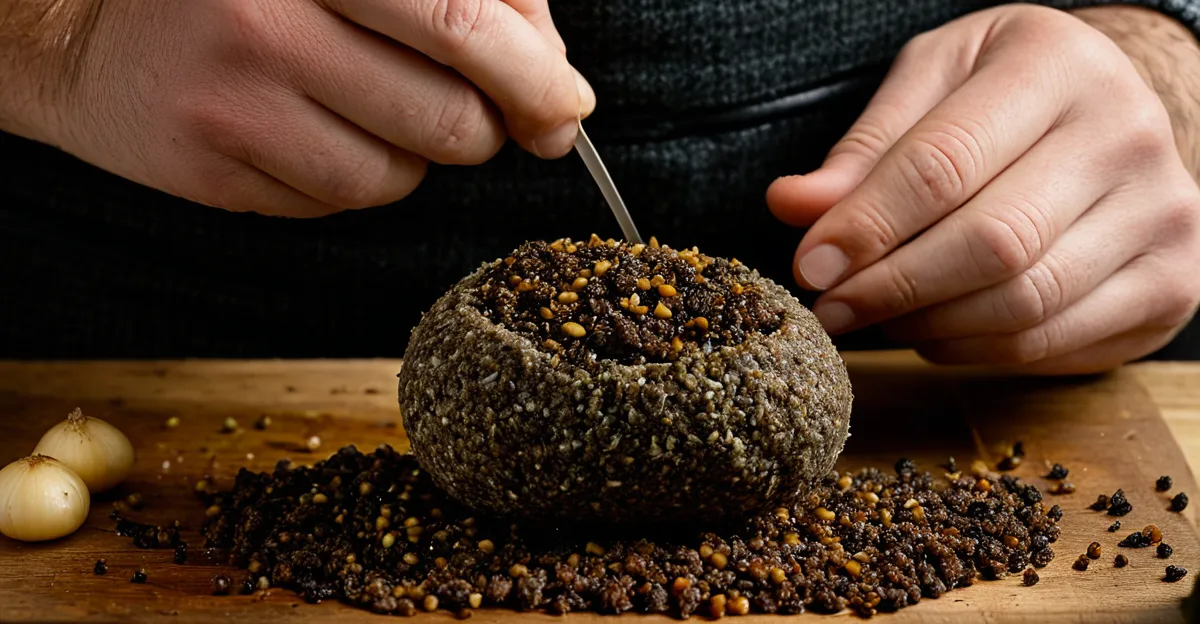Essential ingredients and sourcing authentic haggis components
To create authentic Scottish haggis, it is vital to start with traditional haggis ingredients. The core component is sheep’s pluck—specifically the heart, liver, and lungs. These offal pieces provide the rich, distinctive flavour that defines haggis. Sourcing sheep’s offal may be challenging outside Scotland, but specialty butchers or farmers’ markets often carry them. Where unavailable, some cooks turn to high-quality lamb organs as substitute ingredients, although this slightly alters the taste.
Oatmeal plays an important role in haggis, absorbing juices and adding a nutty texture. Scottish or pinhead oatmeal is preferred for authenticity, and suet adds necessary fat, keeping the mixture moist during cooking. A mixture of warming spices like black pepper, coriander, and nutmeg completes the traditional profile.
In the same genre : What are the best tips for cooking a hearty Lancashire hotpot?
Choosing fresh, quality ingredients is crucial. Freshness of the sheep’s pluck impacts flavour sharply, so prioritize suppliers with strict hygiene standards. Similarly, using fresh oatmeal and suet ensures the dish’s texture and taste meet expectations.
By carefully sourcing authentic haggis ingredients or reliable substitutes, and focusing on quality, you lay the foundation for a truly flavourful and culturally faithful haggis.
Also to see : Discover the Rich History of British Culinary Traditions?
Preparation steps for traditional haggis
Preparation of authentic Scottish haggis begins with meticulous haggis preparation. The first step involves prepping sheep’s pluck—the heart, liver, and lungs. These must be thoroughly cleaned to remove any impurities. Traditionally, the offal is gently boiled for about an hour to soften the texture and make it easier to handle. Proper boiling also helps eliminate unwanted gamey flavours while preserving the essential taste.
Once cooled, the offal is finely chopped or minced to create a uniform mixture. This forms the base of the haggis, allowing the haggis ingredients to bind effectively with oatmeal and spices. Adding diced onions, pinhead oatmeal, and rendered suet to the offal enriches the texture. Essential spices, such as black pepper, coriander, and nutmeg, are incorporated at this stage to infuse the mixture with the iconic haggis flavour.
The mixture is then stuffed into a cleaned sheep’s stomach casing, traditionally used for authentic Scottish haggis. Securing the casing tightly is key to avoid leakage during cooking. If a sheep’s stomach is unavailable, synthetic casings can serve as valid substitute ingredients without drastically compromising authenticity. Mastering these preparation steps ensures the foundation of a well-made haggis that delivers both traditional taste and texture.
Cooking methods to achieve authentic flavour and texture
Achieving authentic flavour and texture in haggis depends heavily on how to cook haggis properly. The most traditional method involves gently boiling haggis for about 1.5 to 2 hours. This slow simmering ensures the casing stays intact while allowing the haggis ingredients to meld, creating a moist and tender filling. High heat can cause bursts or dryness, so maintaining a gentle boil is essential.
During cooking, avoid overcrowding the pot to ensure even heat distribution. Some cooks recommend pricking the casing lightly to release excess steam, preventing swelling and potential rupture. Keeping the haggis submerged and checking water levels regularly helps sustain consistent temperature.
For traditional haggis methods, resting the haggis after cooking allows the juices to redistribute, enhancing texture and flavour. This step is often overlooked but is crucial for maximum taste. If using substitute ingredients or synthetic casings, cooking times might vary slightly, so monitoring progress is important.
In summary, mastering how to cook haggis requires patience, gentle simmering, and attention to detail. Proper boiling locks in moisture, preserves flavour, and ensures that the well-prepared mixture results in a truly flavourful haggis with the right texture.






